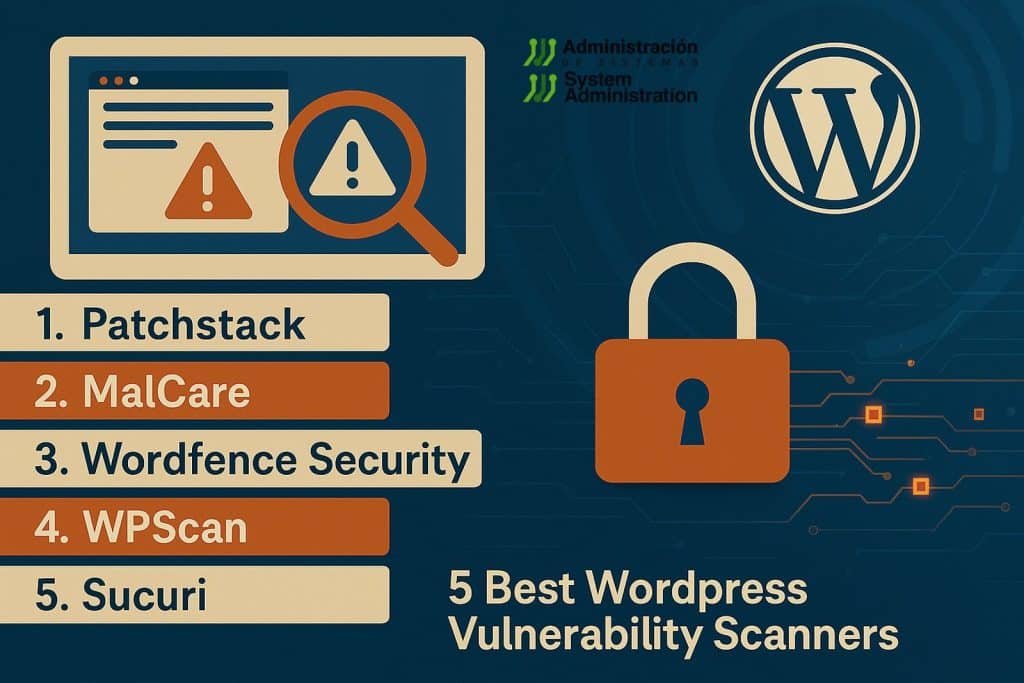With WordPress powering over 40% of the internet, it remains one of the most popular — and most targeted — platforms in the world. While its flexibility and ecosystem of plugins and themes make it incredibly versatile, they also introduce potential security gaps that attackers are constantly looking to exploit.
That’s why using a WordPress vulnerability scanner is no longer optional — it’s essential. These tools proactively check your website for security flaws, outdated components, and known vulnerabilities before they’re exploited.
In this guide, we highlight the top 5 WordPress vulnerability scanners in 2025, including both free and premium options, and walk you through how to use them effectively. Whether you’re a blogger, business owner, or dev agency, these tools can help keep your WordPress installation safe.
🔒 Top WordPress Vulnerability Scanners in 2025
1. Patchstack – Early Detection and Virtual Patching
Patchstack specializes in detecting vulnerabilities in plugins and themes. It offers virtual patching, which shields your site from known threats even before official fixes are released by plugin developers.
Highlights:
- Virtual patching without code changes.
- 48-hour advance protection before public disclosure.
- API access for integration in CI/CD workflows.
- Centralized dashboard for managing multiple websites.
Pricing: Starts at $89/month for 50 sites. Enterprise plans are available on request.
2. MalCare – Smart Updates and Auto Malware Removal
MalCare is an all-in-one security platform that includes malware scanning, vulnerability detection, and auto-cleanup. Its “Safe Updates” feature tests plugin updates for visual issues before deploying them live.
Highlights:
- Daily scans against a maintained vulnerability database.
- Auto-updates with regression testing.
- Real-time firewall and instant malware removal.
Pricing: Starts at $149/year for one website. Plans scale up to $499/year for more features and faster support.
3. Wordfence – Real-Time Threat Intelligence for WordPress
Wordfence is one of the most popular WordPress security plugins. Beyond scanning, it offers a comprehensive threat intelligence platform, firewall, and CLI tools for advanced users.
Highlights:
- Free vulnerability intelligence platform with webhook support.
- Real-time attack stats and global IP threat feeds.
- CLI tools for server-level scanning.
Pricing: The core intelligence platform is free. Premium plugin plans start at $149/year.
4. WPScan – The Original WordPress Vulnerability Database
WPScan has long been a go-to for developers. It powers vulnerability databases used by Jetpack Protect and others. Known for its manual review process, it offers both web-based and CLI tools.
Highlights:
- 60,000+ vulnerabilities documented.
- CLI tool for in-depth scanning.
- Constant updates from security researchers.
Pricing: Free API access with limits. Enterprise access and advanced APIs available by request.
5. Sucuri – Complete Site Protection with Cleanup Guarantee
Sucuri is more than just a scanner; it’s a full-service website security platform. Their plans include malware cleanup, web application firewall (WAF), and performance optimization via CDN.
Highlights:
- Guaranteed malware removal within 6–30 hours.
- Integrated CDN and caching for performance.
- Detailed monitoring and support 24/7.
Pricing: Starts at $229/year per site. Premium plans reduce response time and increase scan frequency.
🛠️ How to Use a WordPress Vulnerability Scanner
Step 1: Choose and install your scanner
Whether you use a plugin like Patchstack, a remote scanner like Sucuri SiteCheck, or a CLI tool like WPScan, pick the tool that fits your technical level and goals.
Step 2: Configure scan settings
Enter your API keys (if needed), choose notification preferences, and set scan frequencies (daily or weekly recommended).
Step 3: Run your first scan
Look for outdated core, plugins, themes, and misconfigurations.
Step 4: Analyze and remediate
Update or remove vulnerable components, apply virtual patches, and fix misconfigurations.
Step 5: Rerun the scan
Verify the fixes and schedule ongoing scans.
🌐 Why Hosting Matters: Secure Infrastructure Complements Scanning
While scanners are vital, hosting plays a critical role in overall WordPress security. Pairing your vulnerability scanner with a robust, secure hosting stack adds another layer of protection.
Managed platforms like:
…provide optimized server configurations, built-in firewalls (e.g., Fail2Ban, ModSecurity), automated backups, SSL deployment, and security hardening — all essential components for a secure WordPress environment.
However, remember that server-level security does not replace application-level scanning. Hosting stacks can prevent brute-force and pattern-based attacks, but they won’t alert you to a vulnerable plugin version — that’s where vulnerability scanners excel.
✅ Conclusion: Combine Tools for Full Protection
Security is not about a single solution. It’s about layered protection:
- A powerful vulnerability scanner like Patchstack or WPScan
- Regular update hygiene
- Secure, optimized hosting via RunCloud, Xcloud.host, or ServerAvatar
By combining these elements, you drastically reduce the risk of data breaches, defacement, or performance loss.
In 2025, WordPress is more powerful — and more exposed — than ever. Don’t leave your site to chance.
Secure it. Scan it. Host it right.

